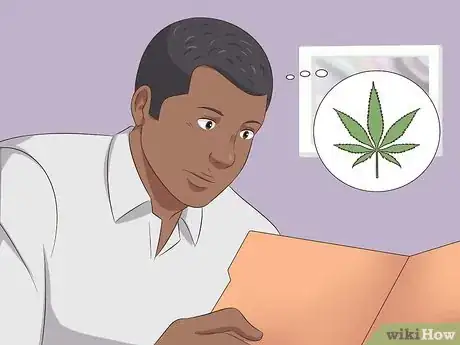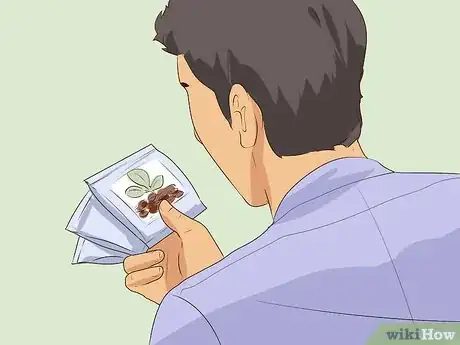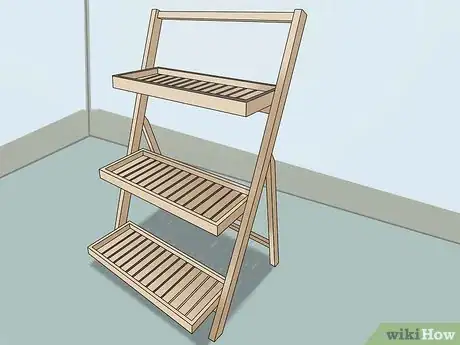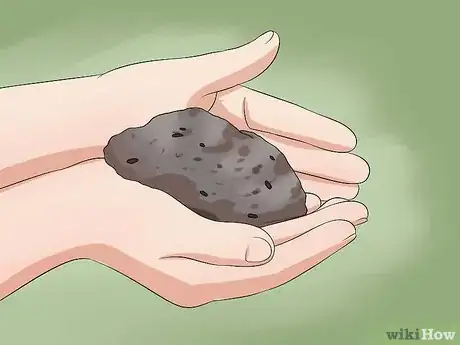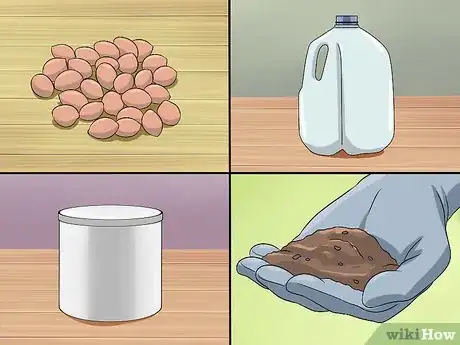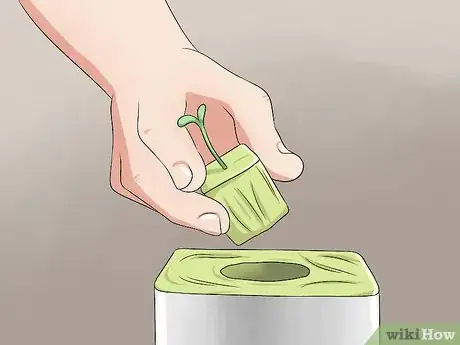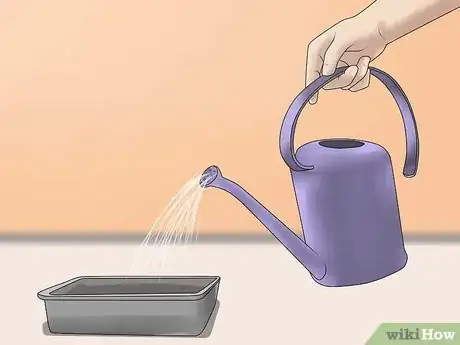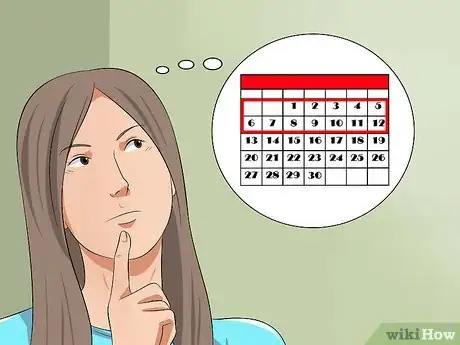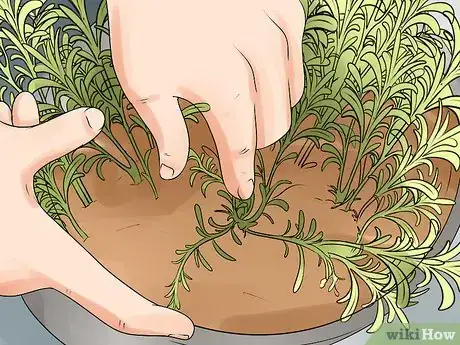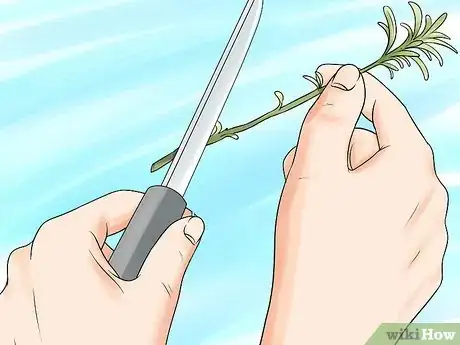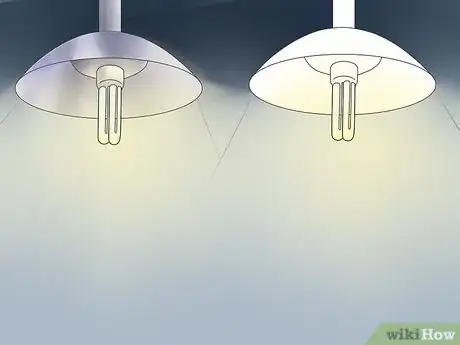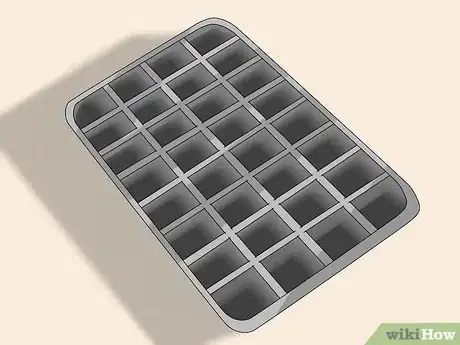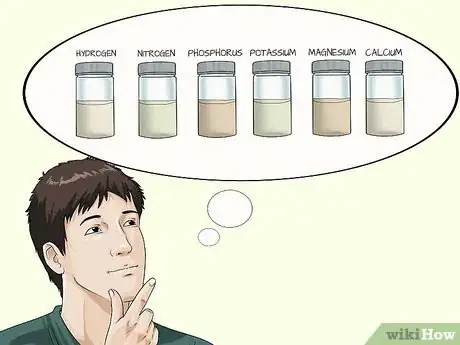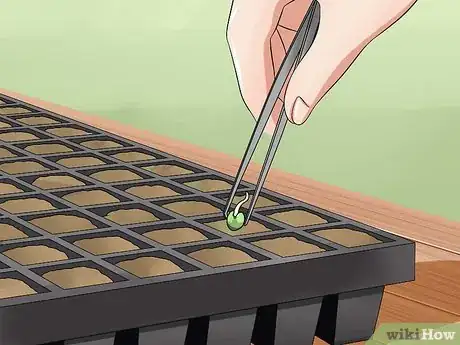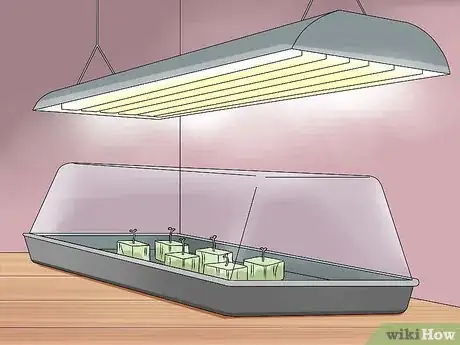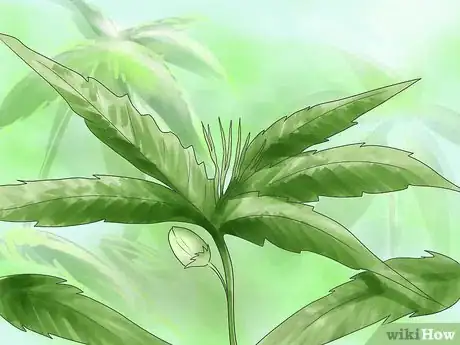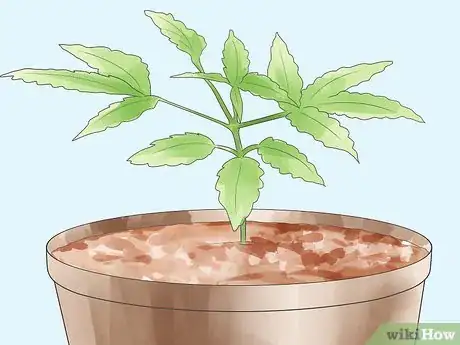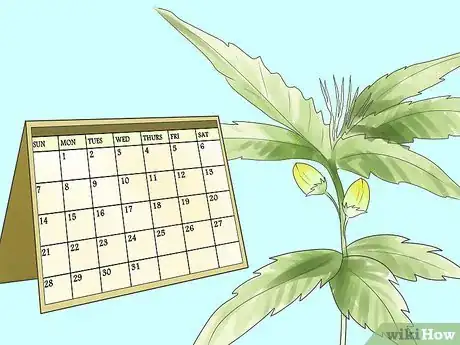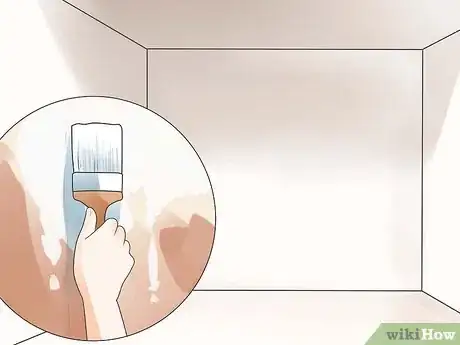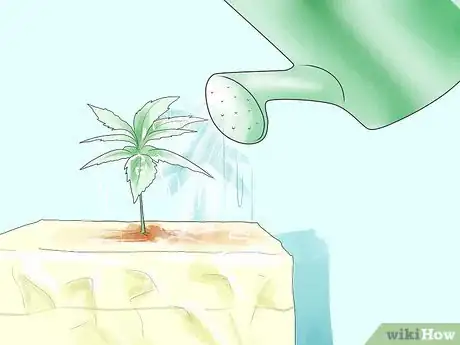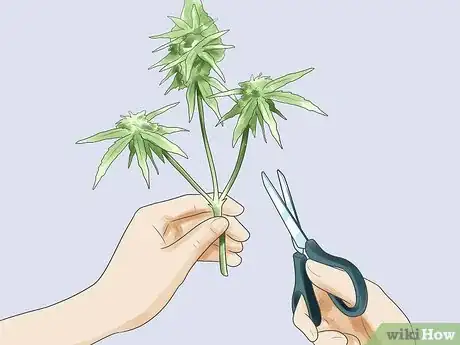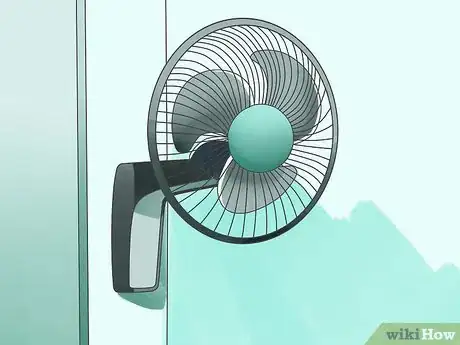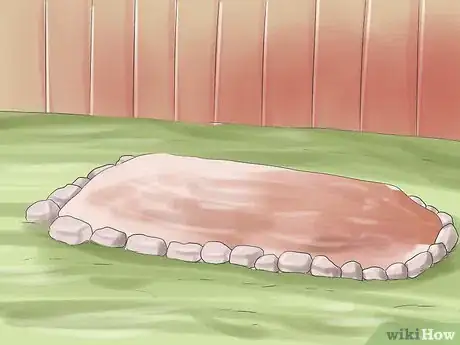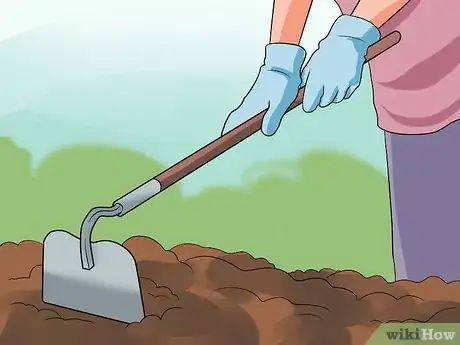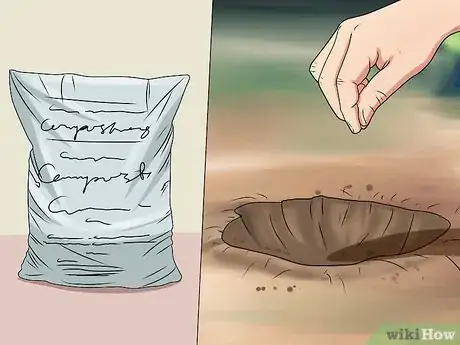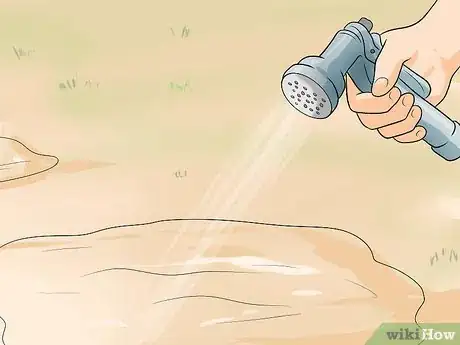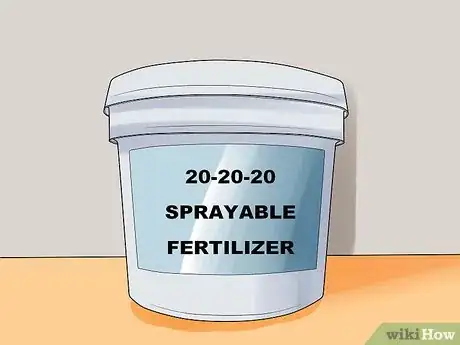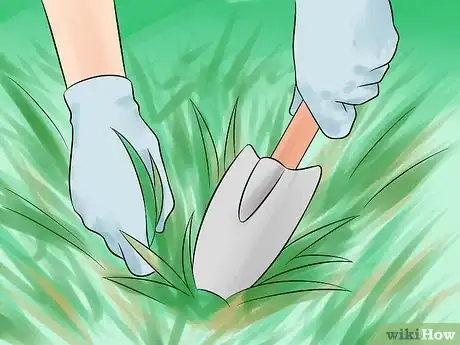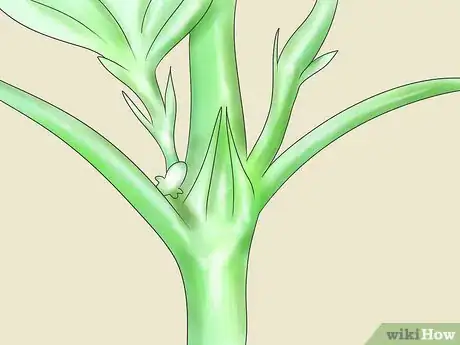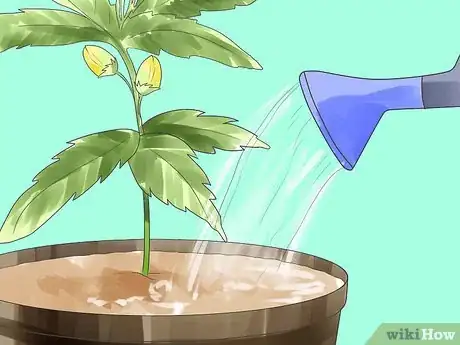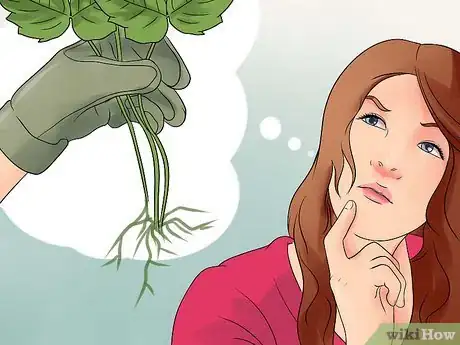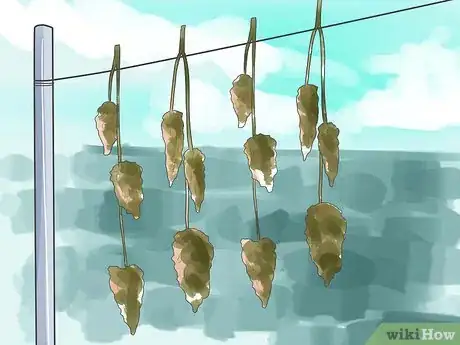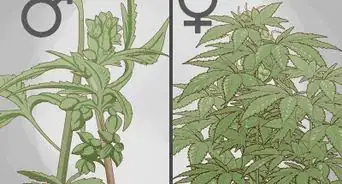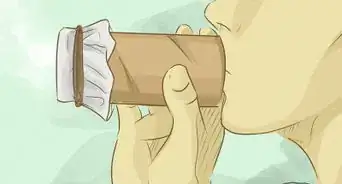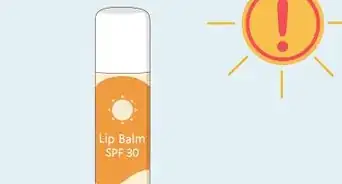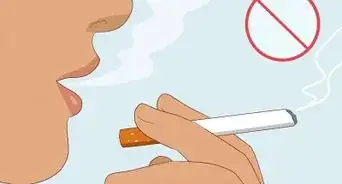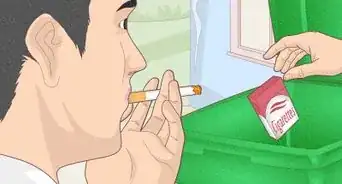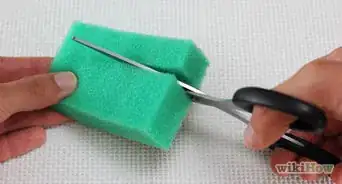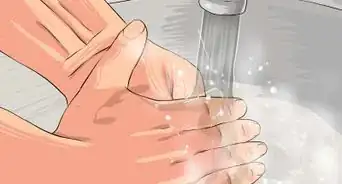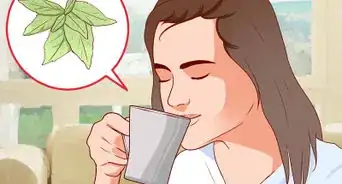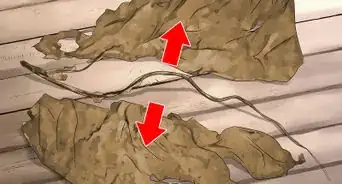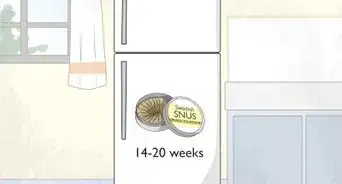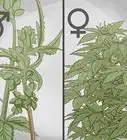wikiHow is a “wiki,” similar to Wikipedia, which means that many of our articles are co-written by multiple authors. To create this article, 48 people, some anonymous, worked to edit and improve it over time.
There are 11 references cited in this article, which can be found at the bottom of the page.
This article has been viewed 339,813 times.
Learn more...
Before reading this article, please check the laws of your jurisdiction. Just because cannabis is legal does not necessarily mean planting them is also allowed. Many places where weed is legal usually have a limit to how many plants of weed you can grow on your property so make sure you're familiar with the laws.
Steps
Understanding the Basics
-
1Know the law. Currently, 36 states and Washington, D.C. have enacted laws to legalize medical marijuana.[1] 18 states and Washington, D.C. have legalized it for recreational use as well. In all states, you must be at least 21 years old to grow cannabis on your property. It's important to know the laws where you live. If you are getting into this business and live in the wrong place and/or do not have a doctor's recommendation for the use of medical marijuana, you are in violation of the law.
- Check up on the policy for where you live. Though legalization seems to be the way of the future, plenty of places are lagging behind.
-
2Know the difference between the strains. Marijuana can be categorized into two main strains: Cannabis Sativa and Cannabis Indica. The former gives the feeling of euphoria and content; the latter gives the classic, heavier, stoned feeling. However, most strains available today are hybrids, which means they have a mix of indica and sativa traits.
- Indicas tend to be shorter and more compact in size; Sativas are longer and leggier.
- There is also a "ruderalis" or "auto-flowering" strains of cannabis. These strains are hybrids that have been bred to have an ability to start making buds automatically after a few weeks. Auto-flowering strains are usually ready to harvest in about 3 months, and they are available in many popular or famous strains.
Advertisement -
3Get your mitts on some seeds. Surprisingly, this isn't super hard. There are a number of companies that are "reputable" and can get the deed done swiftly and discreetly. The best seed sources offer a guarantee.
- Herbies – Located in the United Kingdom they have over 2,500 different seed strains. They deliver worldwide and offer excellent customer service.
- Sensi Seeds – One of the oldest and most respected seed companies based in Amsterdam. The guys over there have spent millions of dollars on their seed stock production and they always offer amazing quality. They do not always send worldwide but you can usually buy their branded seeds from companies that do, like Herbies Sensi Seeds.
- Bonza Seeds – They ship worldwide, free discreet shipping, fully tracked delivery no signature required, delivery guarantee. Bonza mate!
- Gorilla Cannabis Seeds - These guys are UK based and offer great strains like Super Cheese Feminized with historically high 20.94% THC levels and Jack Herer Feminized by Green House Seeds. Contact is excellent with Gorilla Seeds, they actually have a phone they answer and a price-match guarantee.
-
4Choose a spot and/or method. There are advantages and disadvantages to choosing how and where to grow your plant. You can do it indoors, outdoors, or hydroponics style. It's all up to you.
- Growing weed indoors has many advantages when compared to the risks associated with growing marijuana outdoors makes, what with threats from theft and possibly the law if it is illegal to grow where you live. By growing marijuana indoors you can control the ambient conditions just exactly as you want them and grow a nice healthy cannabis plant.
- Growing your plant in the wild allows you to avoid any nosy neighbors and avoid being caught red-handed, but it does force you to relinquish an element of control: You can't control the weather, disease, thieves, or how they grow. However, outside also eliminates the need for an indoor growing room, saving you loads of money initially.
- Hydroponics is the term for growing plants (any kind) without soil. Believe it or not, they don't actually need it. While soil is obviously a source for nutrients, they can be had in alternative ways.
Growing with Soil
-
1Buy yourself some pre-fertilized potting soil. Purchase this in early June. Although this is not usually organic this will be the easiest route and considering that the grower will probably be suffering from a condition of some kind, this will be better. It must have:
- Sufficient nutrients. If you pick up a bag and it says "N-P-K = x%-y%-z%," it's a keeper. This is indicating the levels of nitrogen, phosphorus, and potassium within the soil.
- A pH between 5.9 and 6.5. You can change it yourself, of course. Even the organic fertilizers you buy in the store tend to have pHs that are too low.[2]
-
2Fill a small paper cup with enough of the soil to fill to just below the rim. Moisten the soil and plant the seed about one centimeter deep (1/2"). Do this for each seed you wish to grow. Place the cups in a warm (approx. 70 degrees° F (21°C)) sunny area.
- Water your plant and keep it warm. When your plant sprouts, keep the soil moist and let it grow until the seedling becomes root bound. The entire pot will be filled with roots and will hold the shape of the cup when removed.
-
3Fill a 5 gallon (18.9 L) bucket with holes drilled in the bottom with the soil. Gently remove the seedling from the original container by turning it upside down and gently shaking the container. Gently insert the roots into the soil by making a small hole in the center of the 5 gallon (18.9 L) container and cover the stem to about 2 centimeters (1") from the first set of leaves.
-
4Water your plant until the soil is completely saturated and water only when the soil becomes dry to the touch. Fertilize after about one month with nitrogen fertilizer (follow the instructions for the fertilizer as if you were growing vegetables). Keep the plant in a sunny area at least 8 hours a day and use a natural pesticide if necessary.
- You will hopefully have more than one seed to work with because this is the dicey part. If your plant starts to grow small pods that eventually split and release pollen, you have a male plant -- this contains less of the medicinal qualities and is mostly useful only for cooking. When a male appears, quickly separate it from the other (presumably female) plants and harvest it for cooking (simmering the dried plant material in butter is the most effective way).
-
5Keep an eye on it. The arrival of the male plants (usually in August) will be your cue to fertilize for budding. Use a high Potassium plant food for this and discontinue adding nitrogen. Potassium accelerates the budding process and promotes bud production.
-
6Be patient. When small clusters of white "hairs" appear you will know you have a viable female plant. Wait until the buds are completely mature, usually in mid October. The buds will have hairs that are all orange to a reddish-purple color and be covered in resin containing tiny tri-chromes. Use a magnifying glass and when these turn an amber color they are ready for harvest.
-
7Cut the plant at the bottom and place in a warm, dry, well-ventilated area. The rafters of a barn or garage are usually good for this. By no means is any moisture good; mold will quickly grow and destroy the buds. Hang the plant upside down with newspaper underneath to catch any parts that fall off.
- Cut off all the buds. After they have become "crispy" on the outside, put them into a large plastic bag. On the following day remove the buds and put them in a paper bag for another week or so.
-
8Making sure the buds are completely dry, store them in mason jars for storage and place in a cool dark area.
- This article in no way condones the illegal sale, cultivation, or use of this plant by anyone except those with a valid medical condition and a state issued license. This is intended as a reference only.
Growing Outdoors
-
1Get a plant. Follow basics above or go to the store. Store bought is easier and better as these will be specially picked out and well cared for in advance. Consider local plants are likely to grow better.
-
2Choose a zone. Recommended to have lots of sun and definitely a wide area. Plants next to other plants will simply cause shade on each other. Often plants may be 4- foot diameter; so the next plant ideally should be so far away as to not shade another.
-
3Choose a medium to grow in. The ground is best and easiest and results in larger plants. Pots will limit size. Hydro might work, but probably not worth it.
-
4Prep the the medium. Anything will usually work, but you can improve the growth and viability with steps like "Growing with Soil" above. Looser soil is better for root growth as in all plants. Add compost/chems if you so desire.
-
5As soon as the temp is regularly above freezing and usually in the 40s-50s(f), plant outside.
-
6Water as usual. Most plants will do fine with whatever amount you use. In the ground, you can't really over water. Watch for wilt if you are usually very little or forgetting.
-
7Do not do anything to the plant. Leave the plant alone, it doesn't need your help and won't like it. You can pull dead/dying parts off, but it won't affect it. Only avoid letting dead material rot on the plant itself.
-
8Before the rain/fog/etc comes, cover your plant. (Alternatively, you can cause the plant to flower long beforehand) Wind alone may knock it over, make it strong. Clear/opaque plastic works well. The moment water touches your plant, you are welcoming white mildew and ultimately moldy/rotting flowers. Failing to do this step will cause you hours of picking out bad leaves, etc. or will ruin the entire plant.
-
9Before the rain/fog/etc comes, spray the plant with antifungal products. Organic recommended as you may be consuming whatever you apply. Do this multiple times, ensuring to only cover lightly and only during hotter times so no moisture is allowed to cause mold/mildew. Failing to do this step will cause you hours of picking out bad leaves, etc. or will ruin the entire plant.
-
10Harvest following your preferred harvest steps. Consider doing wet trimming and using machines. You can just remove a branch when you are ready and leave the rest of the plant to continue growing.
Growing with Hydroponics
-
1Master the lighting. When growing outdoors, the sun is all these guys need. But since you're working under a roof, you'll need to recreate the power of that big ball of fire. When they're young, the plants need blue light; when they're older and budding, they need yellow, amber and red light. You have a few different options in building your system:
- High Intensity Discharge (HID) lights such as High Pressure Sodium (HPS) and Metal Halide (MH) lights. These lights produce a lot of heat and are quite powerful, but they use more energy than other types.
- Fluorescent lighting. This type is great for young plants and doesn't use very much electricity. However, once your plants get older, you'll need to get them more light somehow.
- Compact Fluorescent Lights (CFLs). These are easy to find and also don't use much electricity -- because of that, you'll need to stock up. These may be better used as a supplement to a different type of lighting. CFLs should be kept as close as possible to plant leaves without burning them.
-
LED lights. As far as types go, LEDs use less electricity and produce less heat than their competitors. Though when you go about purchasing some, know that certain brands well outrank others in efficacy and durability of product.[3]
- The technology behind LEDs is getting more refined and the new trend is in broad-spectrum LED grow lights. They cover the 420 to 730 growing range and use 82% less electricity than the narrow-spectrum devices. They generally keep cool, don't emit a lot of heat, and last for up to 60,000 hours.
-
2Set up your hydroponic system. There are number of methods to choose from and a plethora of devices that are out there just waiting to be bought. Do the research before you go about choosing anything.
- Wick system: This uses just one pump to keep the solution aerated and a grand total of zero to keep it moving -- super easy for beginners to maintain and use successfully. The plant actually takes in just the amount of solution (nutrients) it needs through the wick (a thick acrylic cord works well), giving it only what it needs.
- Ebb and flow system: This system uses a timed pump and reservoir to give the plants their food about 4 times a day (at least to start). You simply place the plants in pots, then place those pots in a tray that holds about 6" (15 cm) of the nutrient solution you're using. If you're using Rockwool, this system is ideal.
- Top feed growth system: This system is one of the more complex, at least mechanically. Each plant is fed at its base and any run-off is drained back into the reservoir. If you do choose this method, a 15-minute feed 3 or 4 times a day is where you should start.
-
3Get the right hydroponic nutrients. As mentioned before, when you go about purchasing plant food and/or solutions, look for the N-P-K format on the label. Generally, your two options will be 15-15-15 and 20-10-5.
- If you are buying hydroponic nutrients, get the powder kind that mixes with water. It is much cheaper over the long run when you compare it with already mixed solutions.
-
4Germinate your seeds. The standard thing to do is use a Rockwool cube to start the seed on and surround it with whatever growing media you use. Keep the Rockwool cube so that the bottom 70% or so is submerged when the water is at its maximum, but keep the top part above the water so that the seed is never submerged. [4]
- You may also use Vermiculite, Perlite, or clay pellets (in addition to soil). Beginner growers are usually better off buying a medium from the store, whether that be brands like Pro-Mix or Sunshine. When you become more advanced you will want to save money by creating your own medium and generally they are created using the same bases such as sphagnum, peat moss or coco coir.[5]
- That being said, the main advantages of soil are its natural buffering ability in keeping pH constant and it is very forgiving in the event of electrical or mechanical failure when feeding or watering.
- After the seeds have germinated and the root is about a quarter of an inch long, place the seed, root down, on your grow cube or media in your hydroponic cups.
- You may also use Vermiculite, Perlite, or clay pellets (in addition to soil). Beginner growers are usually better off buying a medium from the store, whether that be brands like Pro-Mix or Sunshine. When you become more advanced you will want to save money by creating your own medium and generally they are created using the same bases such as sphagnum, peat moss or coco coir.[5]
-
5Watch for the first stage. The first phase of marijuana growth is called the vegetative phase. If you plan on using LED, MH or HPS right away, start with about 20 inches or more above the top of the plant (less for LEDs) and lower the light an inch or so daily until you think the height is right. Too close and the plants will dry and turn brown; too far and the plants grow too tall as they stretch to get closer to their light source.
- Start high and lower the light an inch or two daily until you think the height is right and the light emitted is being caught well by the plants.
- During the first stage of growth, keep the light on 18 to 24 hours a day minimum. The longer it is on, the faster the plants will grow (but the higher your electricity bill will be).
-
6Watch for flowering. This is when the THC, CBN, and CBD are produced -- the ingredients needed to reach a high. It's only produced on the females and the process is fairly evident; the growing process will slow as the plants devote more energy to creating the buds.
- When the plants are at least 6" (15 cm) high and have 4 sets of leaves, you're in the clear to start the flowering process. For most hydroponic plants, this takes 2-4 weeks, so be patient. When you think your greens are ready to flower, cut the light back to 12 hours a day.
- If your plant has reached that 6" mark and you start flowering anyway, it'll keep growing for up to a month. It should then stop, putting all its energy into producing flowers. If you wait for it to mature a bit more, the process should only take around 10 days.
-
7Consider limiting the height of your plants. Though your first thought should be to mess with the area, not your actual plant. The easiest thing to do is to adjust the height of the light. You can experiment with growing stunted plants, but each method takes a lot of skill and expertise and therefore won't be outlined here.
-
8Be patient. If you did go the hydroponic route, it'll take about 3 to 4 months for your plants to flower. However, there are two methods that speed up the process, though they're quite difficult and should only be left to the pros. But if you're curious:
- Sea of Green, or SOG, is a way of growing cannabis that forces the plants into the flowering stage when young and small. By starting the flowering phase of your marijuana plants after about two weeks of vegetative growth you can harvest many weeks earlier than you would if you grew your plants to full size.[6]
- Screen of Green, or SCROG, is one of the most productive systems for growing weed that there is. Cannabis plants are trained through a horizontal screen placed above them, spreading the tops of the plants along a horizontal plane and encouraging bud formation along the normally neglected branch stems.[7]
-
9Make it dark. You want to get as close to simulating a patch in the woods as possible. During flowering, everything should be dark, dark, and darker still. That means no room light, sunlight, or any other light for half the day (that's 12 hours). The only light that's even remotely acceptable would be equivalent to that of the moon.
- Light that is any stronger could delay flowering. Your plant could become stunted and stay in the vegetative phase, never flowering at all.
- When you start seeing light white hairs near the buds, your plants have started to flower. This should happen just short of or up to 2 weeks into the flowering light cycle. When your plants hit this stage, remove the male plants. Unless you have all female clones, that is. Once alone, the pistils will become the red or white hairs that turn into beautiful buds.
-
10Flush the plants with clean, nutrient-free water. Do this once during the flowering phase and again after 6 weeks and then again just before harvesting. This will help remove any build up of fertilizers within the plants or growing medium, making for a cleaner smoke.
-
11Harvest your plant. It's absolutely imperative, once again, that you are patient. No one can tell you the exact time to harvest your plant -- it varies plant to plant and strain to strain. Normally, the process takes around 2 to 3 months. Once you've been to the rodeo a few times, you'll know.
- As the female flowers grow they form heavy "kolas" or cones. You will notice each ovary swell and tiny crystals will be visible around the flowers. The flowers will become sticky to the touch and the aroma will become pungent. As the flowers swell the white pistils begin to darken, growing from white to a reddish brown. Most growers wish to harvest marijuana plants when THC production has reached its maximum. A rough guide is to wait until around 60% of the white pistils have darkened.[8]
- During this time, you may notice some of the larger leaves yellowing and wilting. This is not cause for alarm and is perfectly natural. Remove these, if you'd like, to allow more light to the rest of the plant.
- As the female flowers grow they form heavy "kolas" or cones. You will notice each ovary swell and tiny crystals will be visible around the flowers. The flowers will become sticky to the touch and the aroma will become pungent. As the flowers swell the white pistils begin to darken, growing from white to a reddish brown. Most growers wish to harvest marijuana plants when THC production has reached its maximum. A rough guide is to wait until around 60% of the white pistils have darkened.[8]
-
12Dry your marijuana. Leave only the buds when you're ready to dry your weed. Attach them to a wire or string and hang them upside down in a cool, dark room. Get the fan circulating or turn on the air as plenty of air movement is necessary for adequate drying. However, know that buds that are forced to dry too quickly get a nasty "green" taste (this is due to the retained chlorophyll).
- Allow your plants around 4 – 7 days to dry completely. Squeeze the buds between your forefinger and thumb -- is it dry? When they are, you should seal them in an airtight jar or bag. For the next few days let them breathe for 15 minutes, twice a day. This cures the buds, ensuring all water is removed and makes them better to smoke -- they get a smooth, sweet taste and have an even burn.
Growing your Plants Away From Home
-
1Pick your site. Choosing the right location is crucial to having a successful harvest. The last thing you want them to be is detected by humans and the second to last thing you want them to be is detected by animals, so choose carefully. Look for tracks and choose an area that you can get to, but that isn't too obvious. Here's what to consider:
- A good, reliable source of water is mandatory. A site situated by the side of a river or stream is ideal, but remember that flooding is a risk in spring or autumn. Look for high water marks, debris in trees or water marks on rocks.
- Avoid areas with pine trees -- the soil is probably too acidic; go for the grassy knoll. Look at what else is already growing at the site. If there are plenty of grasses, weeds and nettles then chances are the location is already blessed with decent soil and water. Woodland sites may also be worth investigating, but think about how the sunlight will filter through the canopy. When inspecting the site, think about how it'll change over the course of the next few months. The sun will get higher (making it hotter) in the summer, getting your plants baked before you do.
- Find a place where your plant can get at least 5 hours of direct sunlight a day. Where will it hit in the morning, the day, and into the evening? How about over the course of the seasons?
-
2Prepare the site. It's easiest to start with a smaller number of plants -- each one should have about 10 feet (3.0 m) in diameter from the next. That sounds like a lot, but it's only 5 feet (1.5 m) on either side for the leaves to grow from. And keep in mind that they could grow up to 5' (1.5 m) tall!
- Clear away any weeds in the immediate vicinity and dig some decent size holes; they should be at least 2 feet (0.6 m) deep and two feet wide. It is best to replace the original soil with your own "clean" soil from the garden supply shop which should include compost and fertilizer. The original woodland soil will usually harbor a number of pests and diseases and may not be of the best quality anyway. It is a good idea to add a thick layer of mulch to the top surface of the growing area to help keep moisture in the ground below.
-
3Plant your seeds. Planting should take place early in the season, around April or May, after the last frost. Obviously the exact timing will depend on where you live -– this is based on the Northern hemisphere (i.e. in time for spring and summer).
- For the southern hemisphere (where spring begins on the 1st of September), watch for a warm spell after that date. Marijuana plants will not tolerate frost so it’s better to be safe than sorry.
- Plant the seeds, sideways, around 1.25cm (1/2”) deep into your prepared soil. Make sure that they are well watered and will not dry out if there are some sunny days. In addition, make sure you keep them moist at all times. After approximately 48 hours you should start to see the first signs of the seed cracking open and the first shoots coming out.
-
4Give your plants a constant source of water. One of the best solutions is to have a stream, river, or lake nearby and hook up a small solar powered pump with a timer on it. That said "best," not "easiest." Think about watering the plants in the early morning and then in the early evening.
- Another solution is to devise your own sort of wick system, as discussed previously. Cut a small half pea size hole into the bottom of a 5 or 10 gallon (18.9 or 37.9 L) (or more) bucket or plastic container. Place the bucket near the plant and use a cloth or cotton rope to form a wick that funnels the water (or nutrient solution) from the hole in the bucket to the soil near the plant.
- You have to get the amount of water down pat. Too much and your plants drown (you'll know when the leaves turn yellow); too little and they just don't grow. You'll end up using around 20 to 40 gallons (75.7 to 151.4 L) each season. It all depends on the type of soil you use, the strain, and the amount of sun your plants get.
-
5Feed your plants with fertilizer. Once established your seedlings will soon enter a vigorous vegetative growth stage. From such fragile beginnings plants quickly become full and robust. It is a good idea during this phase to feed your plants well with some quality, nitrogen rich, fertilizer.
- Unlike growing marijuana indoors you have no control over the duration of the vegetative growth stage and over the course of a summer plants can become huge. But hey, at least there's no marijuana in your house.
-
6About 3 weeks after planting, go and weed around your plants. If your garden is out in the wilderness, unfriendly (and threatening) weeds will soon take over and overcrowd your loveable little seedlings. There’s no need to start a forest fire; just clear an area about 3 feet (0.9 m) (1 m) around each plant.
- Repeat this process again around 3 weeks later. It may be necessary to repeat it again after a further 3 weeks, depending on your site. Most plants, by this time, should be strong enough to make their own space and crowd out weed growth.
- If the weather has taken an unfortunate turn of events, go check your plants for damage. Heavy winds, rains, and drought can all take their tolls on your efforts. However, don't jump the gun -- these plants can hold their own, so don't panic if you live in Seattle.[9]
-
7Sex the plants. Although generally considered one of the trickiest parts of growing your own marijuana, sexing is quite straightforward and will become easier as you gain more experience. The reason for sexing your plants is so that you can remove male plants before they have a chance to pollinate the females. If this occurs the females will start to develop seeds and this will divert their energy from THC production.
- Towards the end of the summer, as the hours of daylight decrease, changing light levels will trigger your plants to produce flowers. The appearance of pre-flowers at branch junctions is what you are looking for.
- Male pre-flowers should be clearly visible to the eye, although a magnifying glass will make your job easier. Male flowers form at the junctions of the branches and stem and the pollen sacs form little balls. Remove these.[10]
-
8Watch for flowering. The female flowers will start to form kolas around the branch junctions with a main one at the growing tip of the plants. If you look closely you will see the seed pods and these will swell; either with seeds if your plant has been pollinated or with THC as false pods if you have removed the males.
- As the flowers become ready for harvest the pistils will darken and the seed pods will be swollen and sticky with resin and THC trichomes. Once most of the pistils are dark, you're ready!
-
9Harvest your crop. Plan this one out (and plan it well) because, if everything goes according to plan, you will be venturing back home with a load of smelly, sticky bud in your trunk. If possible, a nighttime visit would be preferable (you probably figured). Ideally plants will be ready to harvest when the buds have darkened, swollen and are glistening with THC crystals.
- However, guerrilla gardening isn’t always ideal, so keep an eye on the weather forecast. If extreme weather, or worse, an early frost is imminent and your plants are budding, but not fully ripe, it might be worth harvesting early. This is a judgement call and no guide can fully cover all eventualities.
- Harvest the buds with a clean, sharp knife. The fan leaves are usually discarded although some growers like to use them for cooking.
-
10Dry your marijuana. Don’t spoil it now (so close!) by being impatient. The best smoke will come from buds that are dried slowly. Hang the buds separately in a cool, dark, well ventilated area. Allow around 5 days for them to dry properly.
- Some growers use microwaves to dry them out more quickly but this is detrimental to both the quality and the taste of the smoke. Don't do it. [11]
Warnings
- In many areas, growing marijuana is illegal. Be aware of the consequences of your actions before you undertake any of these activities. And even if cannabis is legal, remember that you cannot fly with it.⧼thumbs_response⧽
Things You'll Need
With Soil
- Potting soil
- Cup
- 5 gallon (18.9 L) bucket
- Scissors
- Fertilizer
- Magnifying glass
- Mason jars
With Hydroponics
- A hydroponic system
- Appropriate lighting system
- Growing medium
- Hydroponic nutrients.
Away from Home
- A shovel
- Bags (for transport)
References
- ↑ http://www.governing.com/gov-data/state-marijuana-laws-map-medical-recreational.html
- ↑ http://en.wikipedia.org/wiki/Cannabis_cultivation
- ↑ http://www.growweedeasy.com/basics
- ↑ http://howtogrowmarijuana.com/seed-germination
- ↑ http://howtogrowmarijuana.com/growing-medium
- ↑ http://howtogrowmarijuana.com/sea-of-green
- ↑ http://howtogrowmarijuana.com/screen-of-green
- ↑ http://howtogrowmarijuana.com/harvesting-marijuana-head-body-stone
- ↑ http://howtogrowmarijuana.com/visit-growing-weed
About This Article
Before growing legal cannabis, confirm the laws in your area, and obtain a medical marijuana license if you live in a state where it is legal to get one. Next, purchase seeds from a reputable retailer like Herbies or Sensi Seeds so you can start planting. To grow a plant, fill a paper cup with pre-fertilized potting soil that’s rich in nutrients like nitrogen and phosphorus. Moisten the soil, drop one seed in and give it plenty of light and water to help it grow. For more tips on how to grow legal cannabis, like how to grow cannabis hydroponically, keep reading!

